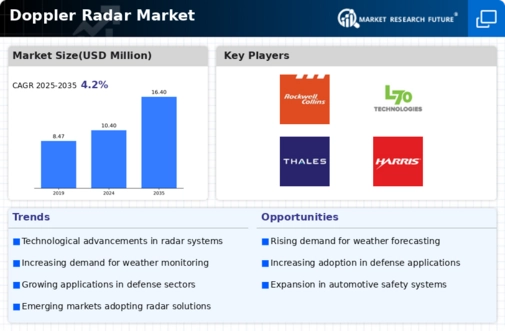Top Industry Leaders in the Doppler Radar Market

Strategies Adopted:
Product Development: Key players focus on developing advanced Doppler radar systems with enhanced capabilities, such as higher accuracy, increased range, and improved sensitivity, to cater to the evolving needs of defense, aerospace, and meteorology sectors.
Strategic Partnerships: Collaborations with government agencies, defense contractors, and research institutions are leveraged to enhance product offerings, expand market reach, and strengthen technological expertise.
Geographic Expansion: Companies may explore new geographic markets and regions to capitalize on emerging opportunities and establish a stronger presence in key markets.
Diversification: Key players may diversify their product portfolios by offering integrated solutions that combine Doppler radar technology with other sensors, systems, or services to provide comprehensive solutions to customers.
New and Emerging Companies:
Rockwell Collins Inc. (U.S.)
Lockheed Martin Corporation (U.S.)
L3 Technologies (U.S.)
SAAB AB (Sweden)
Honeywell International (U.S.)
Northrop Grumman Corporation (U.S.)
Thales Group (France)
General Dynamics Corporation (U.S.)
Kelvin Hughes (U.K.)
Exelis (U.S.)
Factors for Market Share Analysis:
Technology Innovation: Continuous innovation in Doppler radar technology, including advancements in signal processing algorithms, antenna design, and integration capabilities, plays a crucial role in gaining market share.
Performance and Reliability: The performance, reliability, and accuracy of Doppler radar systems significantly influence market share, with customers preferring solutions that offer superior performance under various operating conditions.
Regulatory Compliance: Adherence to regulatory standards and certifications, such as MIL-STD-810G and RTCA DO-160, is essential for gaining market acceptance and ensuring interoperability with existing systems.
Customer Satisfaction: Providing excellent customer support, timely maintenance services, and responsive technical assistance contribute to customer satisfaction and retention, thereby enhancing market share.
Industry News:
Technological Advancements: Updates on advancements in Doppler radar technology, including the development of next-generation systems with improved performance, reduced size, and enhanced functionalities.
Contract Awards: Announcements of contract awards and procurement programs by government agencies, defense departments, and aerospace organizations for Doppler radar systems and related services.
Market Trends: Insights into emerging trends, such as the increasing demand for Doppler radar systems in weather monitoring, air traffic control, surveillance, and defense applications.
Current Company Investment Trends:
Research and Development: Investments in R&D to drive innovation, develop cutting-edge technologies, and stay ahead of the competition in the Doppler radar market.
Strategic Acquisitions: Companies may pursue strategic acquisitions of technology startups or niche players to augment their product portfolios, expand their market reach, and strengthen their competitive position.
Market Expansion: Investments in market expansion initiatives, including sales and marketing efforts, distribution networks, and partnerships, to capitalize on growth opportunities and penetrate new market segments.
Overall Competitive Scenario:
Intense Competition: The Doppler radar market is highly competitive, with key players competing based on product performance, reliability, innovation, and customer satisfaction.
Innovation: Continuous innovation and technological advancements are crucial for maintaining a competitive edge in the market and addressing evolving customer requirements.
Strategic Partnerships: Collaborations and partnerships with industry stakeholders, research organizations, and government agencies play a vital role in enhancing product offerings, market reach, and competitive positioning.


